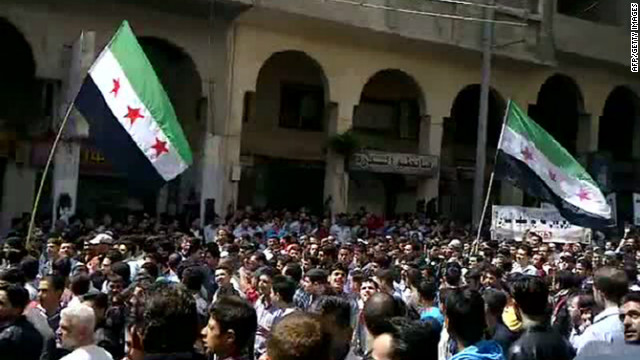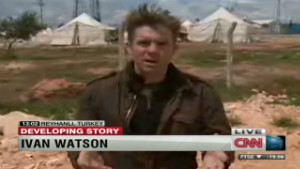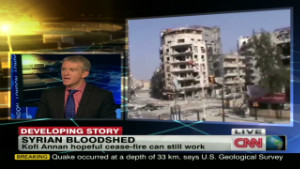April 13, 2012 -- Updated 2226 GMT (0626 HKT)

Deaths amid fragile Syria cease-fire
STORY HIGHLIGHTS
- NEW: Countries may meet next week in Paris
- NEW: Friday's death toll is 13, an opposition group says
- The government blames "terrorist groups" for the violence
- The special international envoy says Syria has not fully complied with a peace plan
Are you there? Send us your images or video. Also, read this report in Arabic.
(CNN) -- Syrians poured into the streets after
Friday prayers, chanting and raising opposition flags in a major test of
a fragile cease-fire implemented a day earlier to end a bloody
government crackdown.
"God, we have no one to ask for help but you," they chanted. "Down with Assad!"
The opposition called for
protests, seemingly testing whether President Bashar al-Assad would
stick to a provision in a six-point peace plan that allows peaceful
demonstrations.
Heavy security remained
in the capital of Damascus and elsewhere, including Hama province and
farther south in Homs, opposition activists said. Snipers remained
perched on roofs in some towns, they said.
 Signs of hope in Syria conflict
Signs of hope in Syria conflict
 Protests test Syria's cease-fire
Protests test Syria's cease-fire
 Blair: No confidence in what Syria says
Blair: No confidence in what Syria says
"It is a normal day like
any other day. The troops have not withdrawn at all. Two of my relatives
and friends were arrested," said Tariq, an activist just outside the
city of Homs, whose name was withheld for security reasons. "The
protests are peaceful, but there is still shelling and we are still
under siege."
The rallies came amid
reports that Syrian troops had clashed with defecting soldiers near the
Turkish border in a violation of the cease-fire, the Syrian Observatory
for Human Rights said. The border clashes occurred in Kherbet Joz
village.
"In the incident,
military forces moved in as part of an operation to attack one of the
areas where defecting militants were based," the opposition group said.
"Initially, the militant group tried to avoid clashing with the security
forces, so it withdrew. But later, clashes did erupt and lasted for a
few minutes."
The state-run SANA news
agency reported that an "an infiltration attempt from Turkey to Syria by
an armed terrorist group was thwarted."
Elsewhere in Syria,
clashes left at least 13 people dead Friday, according to the opposition
Local Coordination Committees (LCC) of Syria. The deaths occurred in
Hama, Daraa, Hasaka and Idlib provinces.
The Syrian Observatory
for Human Rights reported that a Hama death was a protester killed by
security forces gunfire as he headed to a main square to join other
demonstrators.
As it has in the past, the government blamed "terrorist groups" for the violence.
SANA also reported that
an "armed terrorist group" killed an officer in Hama and that a law
enforcement officer was killed by the same type of group in Aleppo.
These groups and their supporters aim to derail the peace plan, the news agency reported.
CNN is unable to
independently verify reports of violence and deaths as the government
has severely restricted access by international media.
Both sides have reported
scattered violence since the cease-fire was implemented at dawn
Thursday. The world turned a skeptical eye toward Syria after the truce
cast relative calm over cities and towns previously pounded by
government forces.
"Syria is apparently
experiencing a rare moment of calm on the ground," Kofi Annan, the
special international envoy who brokered the peace plan, said at the
time. "This is bringing much-needed relief and hope to the Syrian people
who have suffered so much for so long in this brutal conflict. This
must now be sustained."
The cease-fire is part
of a six-point Annan plan that includes the release of detainees,
allowing access for humanitarian aid and international media, and
respecting the rights of peaceful demonstrators. The plan also calls for
the withdrawal of troops and heavy weapons from residential areas.
However, Syria is not in
full compliance with the peace plan, and troops and heavy weapons
remain in population centers despite an agreement to withdraw, said
Susan Rice, the U.S. ambassador to the United Nations.
 When will the Syria violence end?
When will the Syria violence end?
 U.S. lawmaker: Syria a 'serious challenge'
U.S. lawmaker: Syria a 'serious challenge'
"We are worried about
the operational deployment of heavy armor in population centers," said
Ahmad Fawzi, Annan's spokesman. "They do not belong there. And we are
working with the government and with the opposition for a full cessation
of violence in all its forms. We are thankful that there is no heavy
shelling; that the number of casualties is dropping and the number of
refugees crossing the border is also dropping.
"We are under no
illusion that we have come to the end of this conflict. This is only the
beginning of a long road towards reconciling and towards building the
future that Syrians aspire to."
Damascus needs to abide
by all six points of Annan's peace plan, said Adib al Shishakly, a
member of the Syrian National Council, an umbrella group of exiles.
"They diluted the whole
initiative into one thing: into the cease-fire only," al Shishakly said.
"What happened to the other five?"
Foreign ministers from
the Group of Eight, or G8, welcomed the "fragile cessation of violence"
during a meeting in Washington on Thursday.
"The ministers support
the steps outlined by the special envoy and call for urgent action by
the U.N .Security Council to follow through on those steps, including
the immediate approval of an advance observer mission," the ministers
said in a statement.
The G8 comprises Canada, France, Germany, Italy, Japan, Russia, the United Kingdom and the United States.
The United States is providing the opposition with nonlethal specialized equipment.
President Barack Obama
recently signed off on the aid, which according to two senior officials,
includes medical supplies and communications equipment, plus hardware
and software to avoid being detected by the regime. Still under
consideration and debated, according to the officials, are night-vision
goggles, bulletproof vests and other equipment.
Key countries may meet next week in Paris to discuss the crisis, diplomatic sources said.
The sources said the
meeting is not a done deal, but is likely and could prove timely because
the situation inside Syria could change significantly in the coming
week.
As the international community keeps an eye on the truce, talk of the need for international observers increased.
The Security Council may
vote soon on a draft resolution that demands Syria to allow the
deployment of up to 30 international observers and allow them unimpeded
freedom of movement. The draft also calls on all parties to cease armed
violence. A vote was not expected late Friday.
Bashar Jaafari, Syria's ambassador to the United Nations, said the government would have to approve such a deployment.
Syria's anti-government
protests erupted in March 2011, followed by a bloody government
crackdown. The United Nations estimates at least 9,000 people have died
in Syria since the protests began. The LCC puts the death toll at more
than 11,000.
CNN's Amir Ahmed, Elise Labbott and Moni Basu contributed to this report.

No comments:
Post a Comment